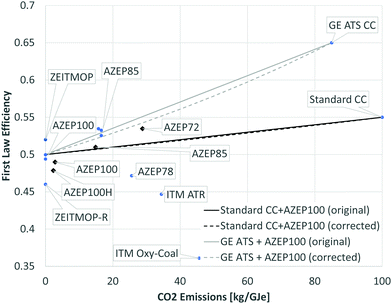 Open Access Article
Open Access ArticleCreative Commons Attribution 3.0 Unported Licence
Correction: Conceptual design and analysis of ITM oxy-combustion power cycles
Andrea
König
 a,
Nick D.
Mancini†
b and
Alexander
Mitsos
a,
Nick D.
Mancini†
b and
Alexander
Mitsos
 *b
*b
aAachener Verfahrenstechnik – Process Systems Engineering, RWTH Aachen University, Forckenbeckstr. 51, 52074 Aachen, Germany
bDepartment of Mechanical Engineering, Massachusetts Institute of Technology, 77 Massachusetts Avenue (MIT 3-158), Cambridge, MA 02139, USA. E-mail: amitsos@alum.mit.edu; Fax: +1 (617)-258-5802; Tel: +1 (617)-324-6768
First published on 23rd November 2018
Abstract
Correction for ‘Conceptual design and analysis of ITM oxy-combustion power cycles’ by N. D. Mancini et al., Phys. Chem. Chem. Phys., 2011, 13, 21351–21361.
In ref. 1 Mancini and Mitsos simulated a variety of ion transport membrane (ITM) power cycles. The authors discussed the benefits of partial emissions cycles over a combination of zero-emissions cycles and conventional combined cycles using a linear combination metric.
Ref. 1 presented the linear combination of the zero-emissions cycle and conventional combined cycle as a line in a graph, i.e., Fig. 8 of ref. 1 with First Law Efficiency and CO2 emissions as evaluation criteria. Ref. 1 thus implied that the First Law Efficiency of a linear combination of non-hybrid plants can be determined by simple linear interpolation of the efficiencies of each non-hybrid plant, i.e.,
 | (1) |
 | (2) |
It can be seen that ηlincom,incorrect is not equivalent to the overall First Law Efficiency,  . Instead, one should use a reverse linear interpolation. Then Ẇout,i is canceled out, such that the overall First Law Efficiency of the linear combination is correctly determined,
. Instead, one should use a reverse linear interpolation. Then Ẇout,i is canceled out, such that the overall First Law Efficiency of the linear combination is correctly determined,
 | (3) |
Ref. 1 correctly used a linear interpolation for the second performance criterion, i.e., CO2 emissions. This leads to an inverse relationship of the two performance criteria, i.e.,
 | (4) |
Based on this insight, Fig. 1 shows how the performance line of Fig. 8 in ref. 1 has to be amended.
 | ||
| Fig. 1 Corrected linear combination originally from ref. 1. | ||
When comparing the corrected function to the line originally illustrated in ref. 1 it becomes clear that the actual performance of a linear combination is slightly worse than previously indicated. Thus, from a relative perspective, partial emission cycles perform slightly better than previously thought.
In conclusion, the application of the linear combination in ref. 1 is incorrect but results in very small numerical errors.
The Royal Society of Chemistry apologises for these errors and any consequent inconvenience to authors and readers.
References
- N. D. Mancini and A. Mitsos, Phys. Chem. Chem. Phys., 2011, 13, 21351–21361 RSC.
Footnote |
| † Present address: Tesla Inc., 3500 Deer Creek Rd., Palo Alto, CA 94304, USA. |
| This journal is © the Owner Societies 2018 |
